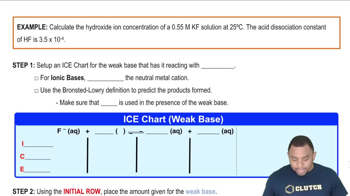Here are the essential concepts you must grasp in order to answer the question correctly.
Solubility and pH
The solubility of certain compounds can be affected by the pH of the solution. In acidic conditions, some metal hydroxides, like Fe(OH)3, can dissolve more readily due to the formation of soluble metal complexes or the reaction of hydroxide ions with protons, leading to increased solubility.
Recommended video:
Net Ionic Equations
A net ionic equation represents the chemical species that are involved in a reaction, excluding spectator ions. It highlights the actual chemical change occurring in the solution, which is particularly useful for understanding the dissolution process of compounds in different pH environments.
Recommended video:
Dissolution of Metal Hydroxides
Metal hydroxides, such as Fe(OH)3, typically have low solubility in water. However, in acidic solutions, they can dissolve by reacting with hydrogen ions to form soluble metal ions, such as Fe^3+, thus demonstrating a shift in solubility based on the solution's acidity.
Recommended video:
Hydroxide Ion Concentration Example




